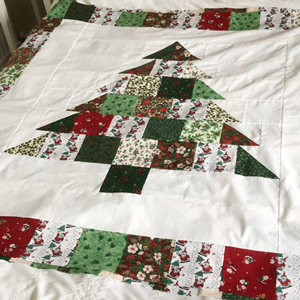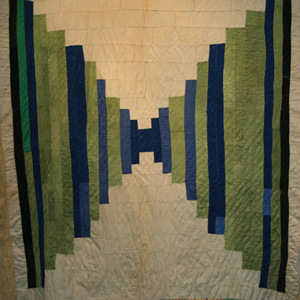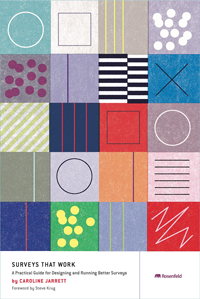There’s a dilemma in the world of surveys: we want to find out lots of things by asking people questions, but they do not want to answer Big Honkin’ Surveys any more.

Patchwork is the art of putting small pieces together to make something else
Patchworkers take small pieces of fabric and sew them back together to make a pictorial or abstract design.
It’s a craft that I’ve always wanted to try. Last year when my book on surveys came out I was finally able to start. One of my earliest efforts is a Charming Tree, a beginner-friendly design by Pat Sloan. I included one fabric, featuring ‘climbing Santas’, that I really dislike but couldn’t quite bring myself to throw away.
In the words of Bonnie K. Hunter, a leading quilt designer and teacher: “No fabric is ugly when you cut it small enough”. Patchworking is about taking what you have, maybe making it smaller, and putting it back together harmoniously. And that’s a strategy that you can also use with surveys.
Cut your questionnaires into small Light Touch Surveys
A few years ago, I was inspired by an example from a supermarket chain in the UK, that had a ‘question of the week’ on their checkouts. They explained that they got really good data from it. This made a lot of sense to me, as I realised that if I knew a question was specific to a particular week then I’d probably be willing to put up with quite a narrowly focused, possibly even odd, question. They are bit like that ugly fabric – cut the questionnaire up small enough, put the question into the right context (“question of the week”), and it suddenly seems a lot better.
There’s a bonus, too: once you’ve managed to persuade people to answer any question, they are often quite tolerant of one or two follow-up questions. I try to make those little extra questions into ones that will help me to understand the representativeness of the response. In the context of the supermarket, I might ask something about how frequently they visit, or whether they have children, or their age. But not all of these because then it would be growing back into a big survey.
I see so many online questionnaires that waste the first question by asking “Are you willing to respond to our survey?”. The majority of people, sometimes 99% of them, will immediately answer ‘no’. That’s collected some data – but it’s boring data, it only tells us that most people don’t want to answer your survey.
But ironically, they have answered that first question! Why not make it a more interesting one? I’ve seen good results from ‘true intent’ surveys that ask “Why did you come to this website today?”.
Patchwork little Light Touch surveys to create a picture
Little Light Touch Surveys have one question, one or two representativeness questions, and (possibly) an open box to let the people who answer say anything they want. These would have been prohibitively expensive in the olden days when getting a questionnaire to someone you wanted to answer it was a big palaver – involving an actual interviewer, in person or on the phone, or mailing out a paper questionniare in an envelope. Because of these difficulties, it was highly tempting to ask as many questions as you possibly could. I call these the Big Honkin’ Surveys.
These days, surveys are all too easy. They pop up on websites, appear in our inboxes after what feels like every encounter with an organisation, and many receipts are accompanied by a survey invitation. Why not make them into useful Light Touch Surveys?
Patchworking represents to me a way of approaching a survey when you need to find out a lot of information. Instead of rolling out the traditional ‘Big Honkin’ Survey’ you create a number of much smaller surveys, asking your questions in many different ways – not even necessarily to the same people. The rich mix of data you get from all these Light Touch Surveys – and other data gathering routes such as interviews – allows you to build up a picture, piece by piece, until you have created a harmonious whole.
Patchworking can be iterative, too

My interest in quilting and patchwork has been inspired by the modern quilters working today, and also the rich tradition of quilting.
For example, the African-American quilters of Gee’s Bend create beautiful works of art from strips of fabric. Many of their works build up the overall effect by starting with small strips at the centre, then gradually increasing in a harmonious mixture.
That sort of iteration can be an inspiration to us in survey design, too. Start small, try it, keep adding. Think about doing larger samples of the same survey, or switch it up by changing the question. Mix and match, reflect, improve.
Postscript: My book cover celebrates patchworking

I’m so keen on patchworking – as a craft, as an artform, and as a way of doing surveys – that when Lou Rosenfeld asked for suggestions for the cover for my book Surveys That Work, I immediately knew what to ask for: something inspried by patchwork. And the Rosenfeld Media cover designers, the Heads of State, responded with the colourful design that created exactly the harmonious, colourful effect created from small pieces I was hoping for.
